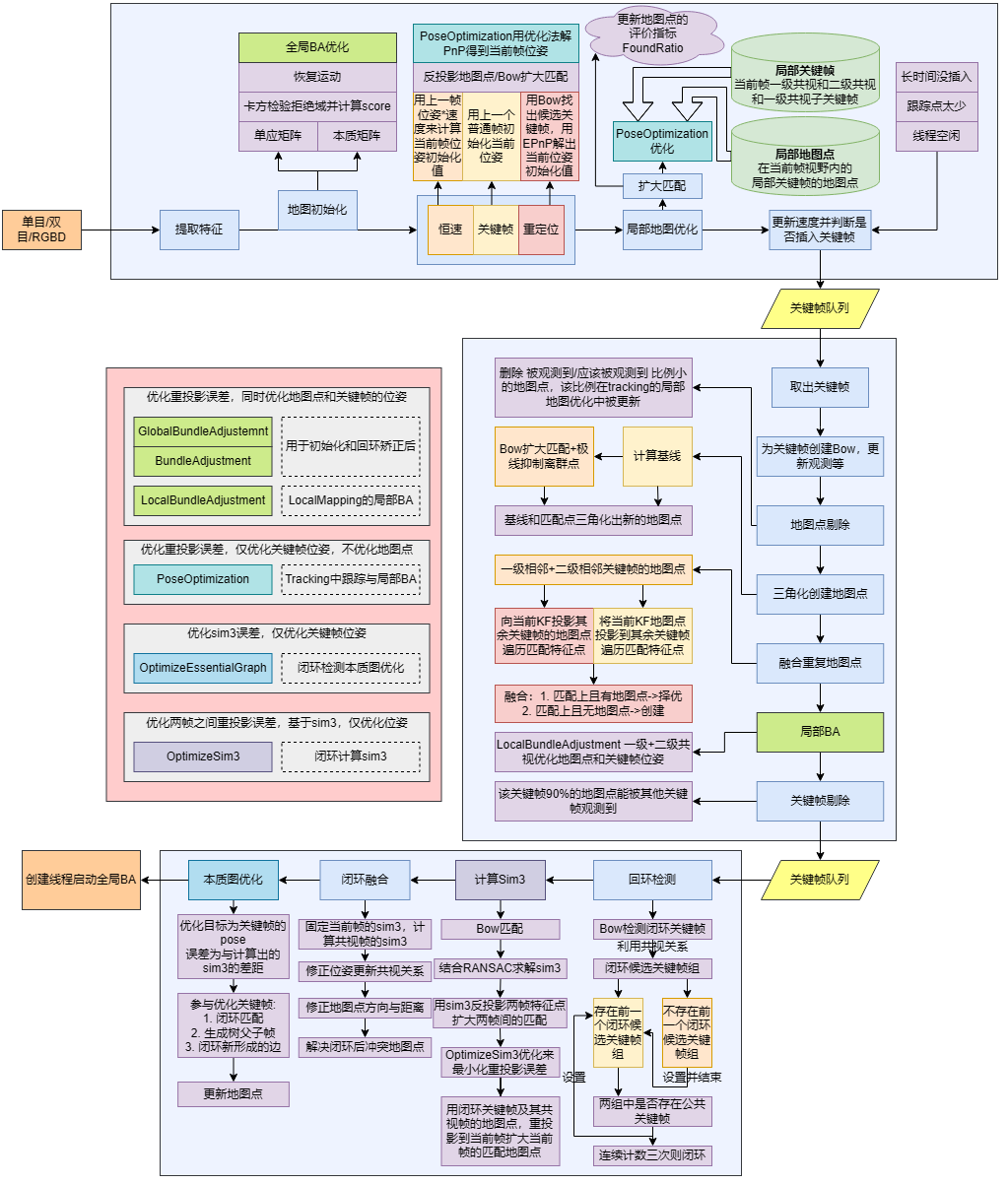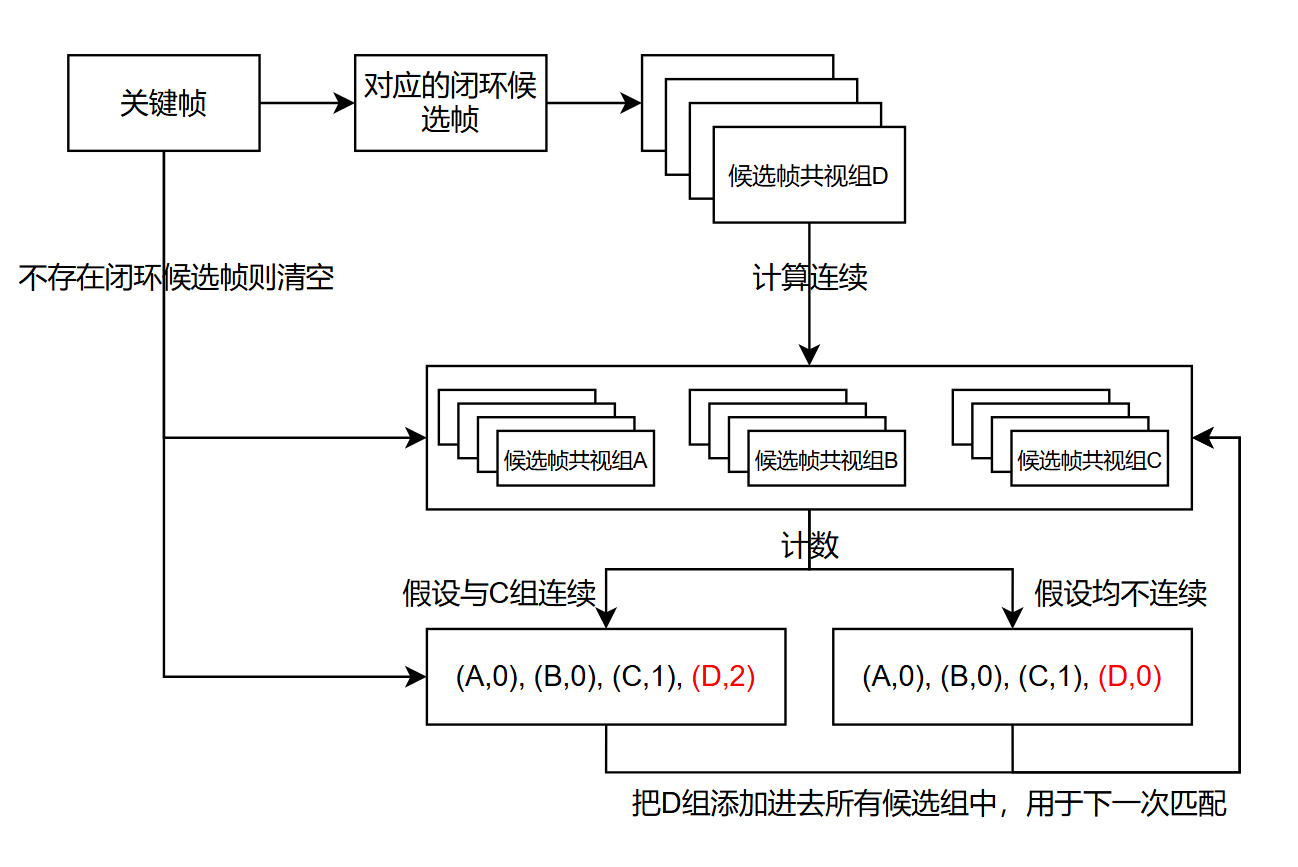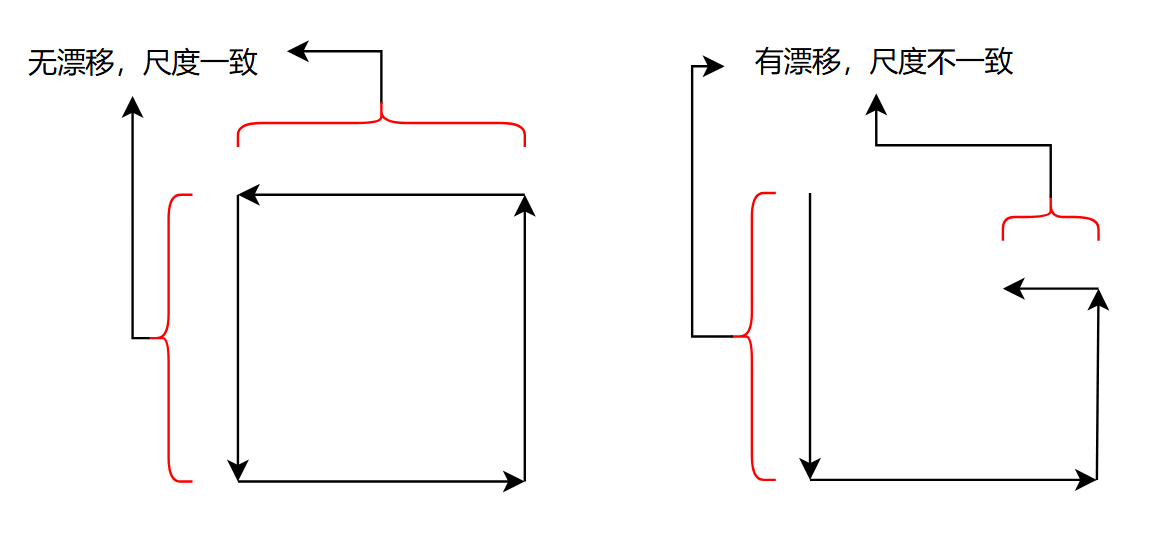ORBSLAM2的回环检测器LoopClosing
回环检测器LoopClosing
ORBSlam2会对每个关键帧检测闭环,整体流程其实就三步:检测闭环、计算变换、闭环矫正。这里面主要的问题是如何检测闭环,必须要严格限制闭环检测的灵敏度,因为错误的闭环的代价非常高。
在检测闭环时,会首先分组并通过计算得分的方式来筛选出闭环候选帧,然后需要保证至少连续三个关键帧都能和闭环候选帧的组有匹配,才认为满足了闭环(后面会细说,大致就是要求一个时间窗口内的关键帧能和已有地图中的一个时间窗口内的关键帧匹配上)
回环检测
在回环检测时,首先使用当前帧的Bow用于匹配器来匹配出闭环候选帧(如何匹配的已经在前文描述了,和重定位类似,都有一个组的概念)。获取到闭环候选帧后,接下来的操作才是重点,为了避免错误闭环,ORBSlam2假设当前帧为A帧,若A帧存在闭环候选帧B帧时,A帧未来几个关键帧也能闭环上且与B帧接下来几个关键帧是有部分视野重合。
那如何体现这个假设呢?ORBSlam2是通过比较共视关键帧是否有重合 来描述的。具体而言,记A帧后面若干关键帧分别为A1,A2...,其候选关键帧存在且对应的闭环候选关键帧为B1,B2...,既然Bi已经是Ai的闭环候选关键帧了,那么说明他们之间一定非常相似,不然肯定无法匹配上因此只需要去判断B帧,B1帧,B2帧...是否存在重合视野即可。
这时,将B帧和其共视关键帧一起作为B帧组,同理也得到B1帧组,B2帧组...然后从B帧组开始,判断B帧组与B1帧组是否存在某个相同的关键帧(即某个关键帧即为B帧的共视,又为B1帧的共视),如果存在这样一个关键帧,就认为B帧组和B1帧组连续 。当存在三个组连续时,那么才认为真的构成闭环了。(注意这个过程中的A1,A2...一定要存在闭环候选帧,如果不存在闭环候选帧那么就会清空所有组然后重新计数)
这里存在三个组"连续"并不要求是三个连续的组"连续"
比如当A1,A2...A10均存在闭环候选关键帧B1...B10时,连续的三个组可以是:
B1组,B2组,B3组 B1组,B3组,B8组 B6组,B8组,B9组 因为统计时是使用元组来计数的,假设某次计数后的元组为(B1,0), (B2,0), (B3,1),新来的组为B4组,且和B3组"连续",那么接下来元组就会变为(B1,0), (B2,0), (B3,1), (B4,2)
下面这个表做了一个模拟
0
C0
无候选
任意
空
1
C1
-
空
(C1,0)
2
C2
-
(C1,0)
(C1,0), (C2,0)
3
C3
C1组
(C1,0), (C2,0)
(C1,0), (C2,0),(C3,1)
4
C4
C2组
(C1,0), (C2,0),(C3,1)
(C1,0), (C2,0),(C3,1), (C4,1)
5
C5
C4组
(C1,0), (C2,0),(C3,1), (C4,1)
(C1,0), (C2,0),(C3,1), (C4,1), (C5,2)
6
C6
C5组
(C1,0), (C2,0),(C3,1), (C4,1), (C5,2)
(C1,0), (C2,0),(C3,1), (C4,1), (C5,2), (C6,3)
1 2 3 4 5 6 7 8 9 10 11 12 13 14 15 16 17 18 19 20 21 22 23 24 25 26 27 28 29 30 31 32 33 34 35 36 37 38 39 40 41 42 43 44 45 46 47 48 49 50 51 52 53 54 55 56 57 58 59 60 61 62 63 64 65 66 67 68 69 70 71 72 73 74 75 76 77 78 79 80 81 82 83 84 85 86 87 88 89 90 91 bool LoopClosing::DetectLoop () ... vector<KeyFrame *> vpCandidateKFs = mpKeyFrameDB->DetectLoopCandidates (mpCurrentKF, minScore); ... for (size_t i = 0 , iend = vpCandidateKFs.size (); i < iend; i++) { KeyFrame *pCandidateKF = vpCandidateKFs[i]; set<KeyFrame *> spCandidateGroup = pCandidateKF->GetConnectedKeyFrames (); spCandidateGroup.insert (pCandidateKF); bool bEnoughConsistent = false ; bool bConsistentForSomeGroup = false ; for (size_t iG = 0 , iendG = mvConsistentGroups.size (); iG < iendG; iG++) { set<KeyFrame *> sPreviousGroup = mvConsistentGroups[iG].first; bool bConsistent = false ; for (set<KeyFrame *>::iterator sit = spCandidateGroup.begin (), send = spCandidateGroup.end (); sit != send; sit++) { if (sPreviousGroup.count (*sit)) { bConsistent = true ; bConsistentForSomeGroup = true ; break ; } } if (bConsistent) { int nPreviousConsistency = mvConsistentGroups[iG].second; int nCurrentConsistency = nPreviousConsistency + 1 ; if (!vbConsistentGroup[iG]) { ConsistentGroup cg = make_pair (spCandidateGroup, nCurrentConsistency); vCurrentConsistentGroups.push_back (cg); vbConsistentGroup[iG] = true ; } if (nCurrentConsistency >= mnCovisibilityConsistencyTh && !bEnoughConsistent) { mvpEnoughConsistentCandidates.push_back (pCandidateKF); ... } } } if (!bConsistentForSomeGroup) { ConsistentGroup cg = make_pair (spCandidateGroup, 0 ); vCurrentConsistentGroups.push_back (cg); } } ... }
Sim3计算
检测到闭环后需要计算Sim3变换,其实就是两个闭环帧的相对位姿+尺度,需要尺度是因为单目会存在尺度漂移,需要闭环来纠正这个尺度漂移。
ORBSLAM2按以下步骤求解Sim3:
首先用Bow匹配两个闭环帧的匹配点
然后基于上述匹配点来构造Sim3求解器结合RANSAC求解Sim3位姿(具体怎么求解的就不展开了,也是比较基础的东西)
使用Sim3扩大匹配,并将上述求出来了Sim3位姿作为初始值,用优化的方法精细化求解
将闭环候选帧及其共视帧的地图点投影到当前关键帧上,以扩大匹配
判断扩大匹配后的匹配点数目,如果有足够的匹配点数目才认为真的算出了Sim3
1 2 3 4 5 6 7 8 9 10 11 12 13 14 15 16 17 18 19 20 21 22 23 24 25 26 27 28 29 30 31 32 33 34 35 36 37 38 39 40 41 42 43 44 45 46 47 48 49 50 51 52 53 54 55 56 57 58 59 60 61 62 63 64 65 66 67 68 69 70 71 72 73 74 75 76 77 78 79 80 81 82 83 84 85 86 87 88 89 90 91 92 93 94 95 96 97 98 99 100 101 102 103 104 105 106 107 108 109 110 111 112 113 114 115 116 117 118 119 120 121 122 123 124 125 126 127 128 129 130 131 132 133 134 135 136 bool LoopClosing::ComputeSim3 () { ... int nmatches = matcher.SearchByBoW (mpCurrentKF, pKF, vvpMapPointMatches[i]); if (nmatches < 20 ) { vbDiscarded[i] = true ; continue ; } else { Sim3Solver *pSolver = new Sim3Solver (mpCurrentKF, pKF, vvpMapPointMatches[i], mbFixScale); pSolver->SetRansacParameters (0.99 , 20 , 300 ); vpSim3Solvers[i] = pSolver; } nCandidates++; } while (nCandidates > 0 && !bMatch) { for (int i = 0 ; i < nInitialCandidates; i++) { ... Sim3Solver *pSolver = vpSim3Solvers[i]; cv::Mat Scm = pSolver->iterate (5 , bNoMore, vbInliers, nInliers); if (bNoMore) { vbDiscarded[i] = true ; nCandidates--; } if (!Scm.empty ()) { vector<MapPoint *> vpMapPointMatches (vvpMapPointMatches[i].size(), static_cast <MapPoint *>(NULL )) ; for (size_t j = 0 , jend = vbInliers.size (); j < jend; j++) { if (vbInliers[j]) vpMapPointMatches[j] = vvpMapPointMatches[i][j]; } ... matcher.SearchBySim3 (mpCurrentKF, pKF, vpMapPointMatches, s, R, t, 7.5 ); g2o::Sim3 gScm (Converter::toMatrix3d(R), Converter::toVector3d(t), s) ; const int nInliers = Optimizer::OptimizeSim3 (mpCurrentKF, pKF, vpMapPointMatches, gScm, 10 , mbFixScale); ... } } } if (!bMatch) { for (int i = 0 ; i < nInitialCandidates; i++) mvpEnoughConsistentCandidates[i]->SetErase (); mpCurrentKF->SetErase (); return false ; } ... matcher.SearchByProjection (mpCurrentKF, mScw, mvpLoopMapPoints, mvpCurrentMatchedPoints, 10 ); int nTotalMatches = 0 ; for (size_t i = 0 ; i < mvpCurrentMatchedPoints.size (); i++) { if (mvpCurrentMatchedPoints[i]) nTotalMatches++; } if (nTotalMatches >= 40 ) { for (int i = 0 ; i < nInitialCandidates; i++) if (mvpEnoughConsistentCandidates[i] != mpMatchedKF) mvpEnoughConsistentCandidates[i]->SetErase (); return true ; } else { for (int i = 0 ; i < nInitialCandidates; i++) mvpEnoughConsistentCandidates[i]->SetErase (); mpCurrentKF->SetErase (); return false ; } }
回环矫正
计算好了Sim3就可以正式开始闭环融合了,主要有以下步骤:
更新由于Sim3计算时扩大匹配引起的共视关系变化
固定当前帧的Sim3,当前帧共视帧相对闭环候选帧的Sim3
基于此Sim3来更新共视帧和当前帧的地图点,包括观测方向等信息
基于此Sim3来更新共视帧和当前帧的位姿,包括共视关系
将闭环关键帧组地图点投影到当前关键帧组中,融合地图点,优先使用闭环时新增的地图点替换之前的地图点
本质图优化,更新Sim3和地图点
新建全局BA线程来优化所有关键帧的位姿和地图点的位姿
全局BA就是优化重投影误差,所有关键帧和地图点都会参与优化,没什么好说的。值得注意的是这里的本质图优化,它优化的是Sim3位姿,前文在计算Sim3时也有一个优化是优化Sim3位姿的,他们的共性是均不优化地图点,但存在一些区别:
本质图优化:优化多个关键帧,用于调整这些关键帧之间相对的Sim3,这些关键帧包括
闭环时因为地图点调整而出现的关键帧间的新连接关系
生成树的父子关键帧
当前帧与闭环匹配帧之间的连接关系(这里面也包括了当前遍历到的这个关键帧之前曾经存在过的回环边)
共视程度超过100的关键帧
计算Sim3时的优化:只包括当前关键帧和闭环候选关键帧两个关键帧,用于精细求解两帧之间的Sim3
1 2 3 4 5 6 7 8 9 10 11 12 13 14 15 16 17 18 19 20 21 22 23 24 25 26 27 28 29 30 31 32 33 34 35 36 37 38 39 40 41 42 43 44 45 46 47 48 49 50 51 52 53 54 55 56 57 58 59 60 61 62 63 64 65 66 67 68 69 70 71 72 73 74 75 76 77 78 79 80 81 82 83 84 85 86 87 88 89 90 91 92 93 94 95 96 97 98 99 100 101 102 103 104 105 106 107 108 109 110 111 112 113 114 115 116 117 118 119 120 121 122 123 124 125 126 127 128 129 130 131 132 133 134 135 136 137 138 139 140 141 142 143 144 145 146 147 148 149 150 151 152 153 154 155 156 157 158 159 160 161 162 163 164 165 166 167 168 169 170 171 172 173 174 175 176 177 178 179 180 181 182 183 184 185 186 187 188 189 190 191 192 193 194 195 196 197 198 199 200 201 202 203 204 205 206 207 208 209 210 211 212 void LoopClosing::CorrectLoop () ... mpCurrentKF->UpdateConnections (); mvpCurrentConnectedKFs = mpCurrentKF->GetVectorCovisibleKeyFrames (); mvpCurrentConnectedKFs.push_back (mpCurrentKF); KeyFrameAndPose CorrectedSim3, NonCorrectedSim3; CorrectedSim3[mpCurrentKF] = mg2oScw; cv::Mat Twc = mpCurrentKF->GetPoseInverse (); { unique_lock<mutex> lock (mpMap->mMutexMapUpdate) ; for (vector<KeyFrame *>::iterator vit = mvpCurrentConnectedKFs.begin (), vend = mvpCurrentConnectedKFs.end (); vit != vend; vit++) { KeyFrame *pKFi = *vit; cv::Mat Tiw = pKFi->GetPose (); if (pKFi != mpCurrentKF) { cv::Mat Tic = Tiw * Twc; cv::Mat Ric = Tic.rowRange (0 , 3 ).colRange (0 , 3 ); cv::Mat tic = Tic.rowRange (0 , 3 ).col (3 ); g2o::Sim3 g2oSic (Converter::toMatrix3d(Ric), Converter::toVector3d(tic), 1.0 ) ; g2o::Sim3 g2oCorrectedSiw = g2oSic * mg2oScw; CorrectedSim3[pKFi] = g2oCorrectedSiw; } cv::Mat Riw = Tiw.rowRange (0 , 3 ).colRange (0 , 3 ); cv::Mat tiw = Tiw.rowRange (0 , 3 ).col (3 ); g2o::Sim3 g2oSiw (Converter::toMatrix3d(Riw), Converter::toVector3d(tiw), 1.0 ) ; NonCorrectedSim3[pKFi] = g2oSiw; } for (KeyFrameAndPose::iterator mit = CorrectedSim3.begin (), mend = CorrectedSim3.end (); mit != mend; mit++) { KeyFrame *pKFi = mit->first; g2o::Sim3 g2oCorrectedSiw = mit->second; g2o::Sim3 g2oCorrectedSwi = g2oCorrectedSiw.inverse (); g2o::Sim3 g2oSiw = NonCorrectedSim3[pKFi]; vector<MapPoint *> vpMPsi = pKFi->GetMapPointMatches (); for (size_t iMP = 0 , endMPi = vpMPsi.size (); iMP < endMPi; iMP++) { MapPoint *pMPi = vpMPsi[iMP]; if (!pMPi) continue ; if (pMPi->isBad ()) continue ; if (pMPi->mnCorrectedByKF == mpCurrentKF->mnId) continue ; cv::Mat P3Dw = pMPi->GetWorldPos (); Eigen::Matrix<double , 3 , 1 > eigP3Dw = Converter::toVector3d (P3Dw); Eigen::Matrix<double , 3 , 1 > eigCorrectedP3Dw = g2oCorrectedSwi.map (g2oSiw.map (eigP3Dw)); cv::Mat cvCorrectedP3Dw = Converter::toCvMat (eigCorrectedP3Dw); pMPi->SetWorldPos (cvCorrectedP3Dw); pMPi->mnCorrectedByKF = mpCurrentKF->mnId; pMPi->mnCorrectedReference = pKFi->mnId; pMPi->UpdateNormalAndDepth (); } Eigen::Matrix3d eigR = g2oCorrectedSiw.rotation ().toRotationMatrix (); Eigen::Vector3d eigt = g2oCorrectedSiw.translation (); double s = g2oCorrectedSiw.scale (); eigt *= (1. / s); cv::Mat correctedTiw = Converter::toCvSE3 (eigR, eigt); pKFi->SetPose (correctedTiw); pKFi->UpdateConnections (); } for (size_t i = 0 ; i < mvpCurrentMatchedPoints.size (); i++) { if (mvpCurrentMatchedPoints[i]) { MapPoint *pLoopMP = mvpCurrentMatchedPoints[i]; MapPoint *pCurMP = mpCurrentKF->GetMapPoint (i); if (pCurMP) pCurMP->Replace (pLoopMP); else { mpCurrentKF->AddMapPoint (pLoopMP, i); pLoopMP->AddObservation (mpCurrentKF, i); pLoopMP->ComputeDistinctiveDescriptors (); } } } } SearchAndFuse (CorrectedSim3); map<KeyFrame *, set<KeyFrame *>> LoopConnections; for (vector<KeyFrame *>::iterator vit = mvpCurrentConnectedKFs.begin (), vend = mvpCurrentConnectedKFs.end (); vit != vend; vit++) { KeyFrame *pKFi = *vit; vector<KeyFrame *> vpPreviousNeighbors = pKFi->GetVectorCovisibleKeyFrames (); pKFi->UpdateConnections (); LoopConnections[pKFi] = pKFi->GetConnectedKeyFrames (); for (vector<KeyFrame *>::iterator vit_prev = vpPreviousNeighbors.begin (), vend_prev = vpPreviousNeighbors.end (); vit_prev != vend_prev; vit_prev++) { LoopConnections[pKFi].erase (*vit_prev); } for (vector<KeyFrame *>::iterator vit2 = mvpCurrentConnectedKFs.begin (), vend2 = mvpCurrentConnectedKFs.end (); vit2 != vend2; vit2++) { LoopConnections[pKFi].erase (*vit2); } } Optimizer::OptimizeEssentialGraph (mpMap, mpMatchedKF, mpCurrentKF, NonCorrectedSim3, CorrectedSim3, LoopConnections, mbFixScale); ... mbRunningGBA = true ; mbFinishedGBA = false ; mbStopGBA = false ; mpThreadGBA = new thread (&LoopClosing::RunGlobalBundleAdjustment, this , mpCurrentKF->mnId); ... }


